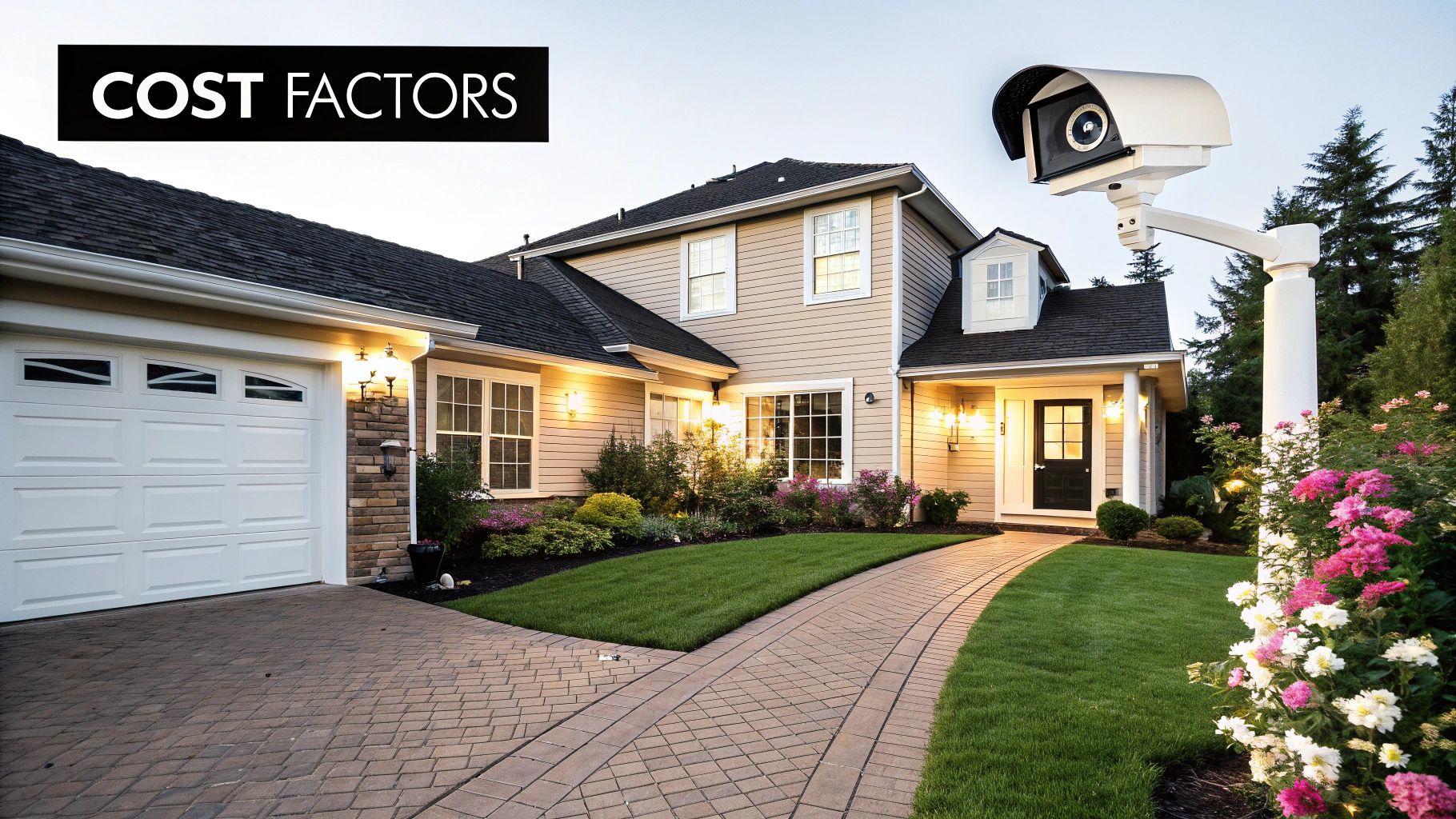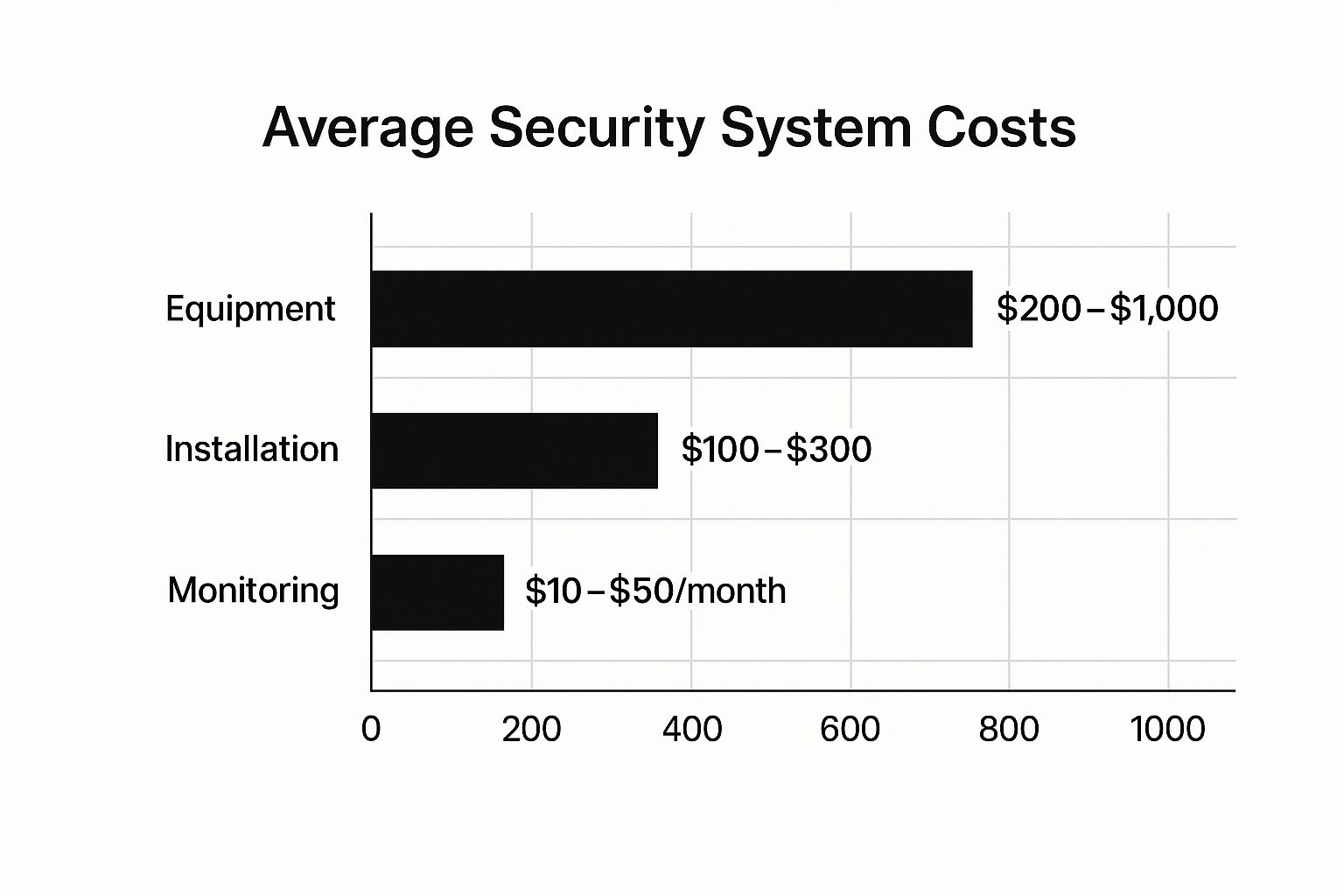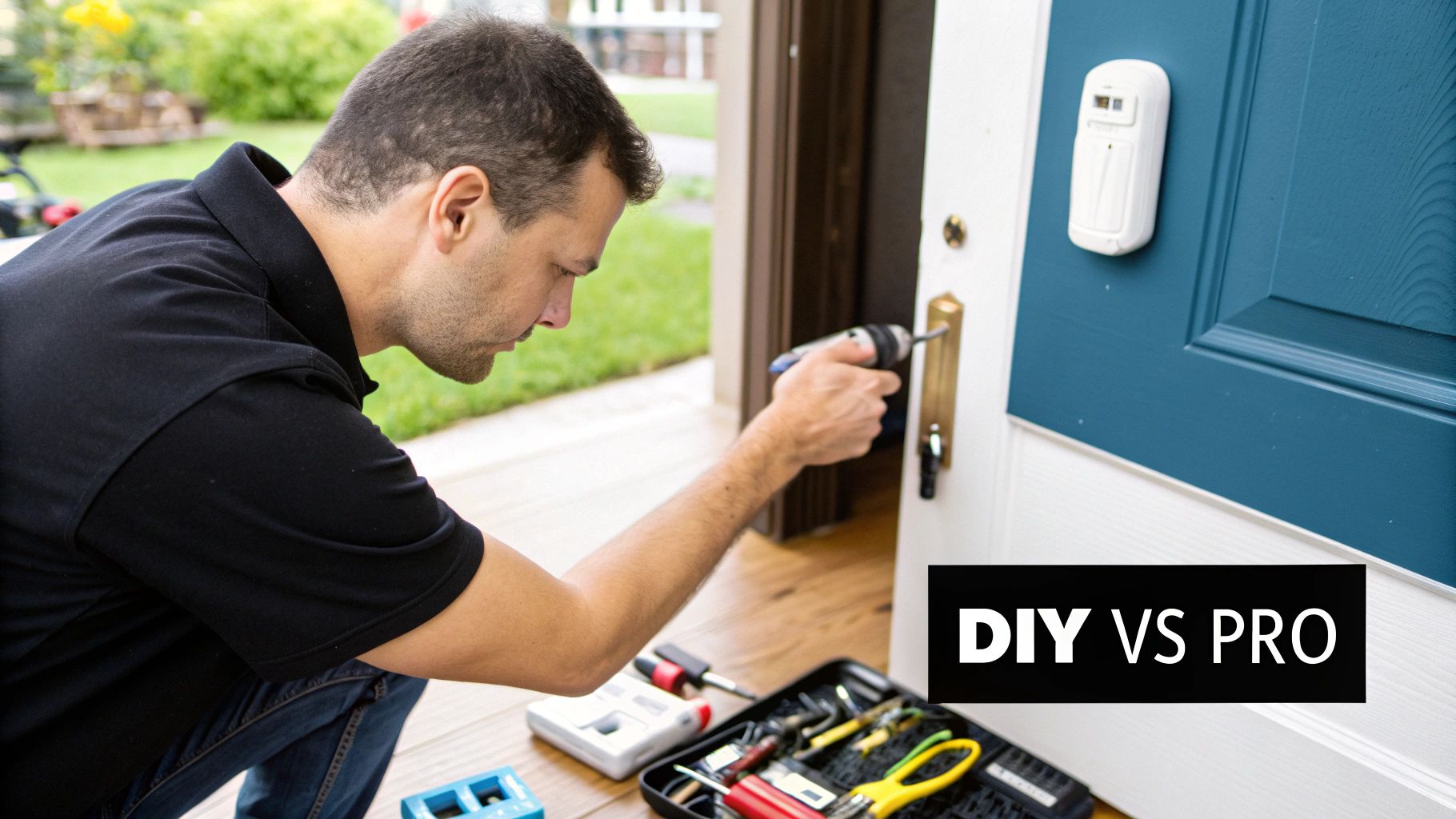Home Security System Cost: Complete Buyer's Guide
- Бонус за регистрацию онлайн казино
- Jun 9
- 13 min read
Updated: Jun 12
Understanding What You're Really Buying

Buying a home security system is a bit like buying a car. You could go for a simple, reliable sedan, or you could choose a fully-loaded SUV. Both get you where you need to go, but the experience – and the price – are worlds apart. Home security is similar. You can find basic starter kits for under $100 or invest in a comprehensive system for over $2,500. The difference isn't just about what you get, but how it protects your home.
Different Needs, Different Solutions
Your neighbor might be happy with a video doorbell, while you’re picturing sensors on every window and door. Why the different approaches? Security is personal. Your home’s layout, your neighborhood, your family, and even your comfort level all play a role.
For example, a family with young children might want indoor sensors and professional monitoring for immediate help in an emergency. Someone living alone in a secure apartment building, on the other hand, might be fine with a DIY system and a couple of cameras.
The Psychology of Security Spending
There's more to security than just preventing break-ins. It's about peace of mind. This "feeling safe" aspect influences how much we're willing to spend. Someone in a high-crime area might invest in a top-of-the-line system even if their actual risk isn’t that high. Conversely, someone in a quiet neighborhood might not think about security until something happens. So, how much should you spend?
Identifying Your True Security Requirements
Don’t let a salesperson tell you what you "need." Figure out your vulnerabilities first. Think about easily accessible windows, your neighborhood’s safety, and how often you travel. This helps you pinpoint where security upgrades will be most effective.
Consider your lifestyle, too. Do you want to control your system remotely from your phone? Is smart home integration important? These features add to the overall cost. Keep in mind, the price of home security systems varies widely. You might pay less than $100, or upwards of $2,000 depending on the equipment and provider. Professional installation usually costs between $100 and $200, while monthly monitoring can range from under $20 to over $60. Discover more insights about home security system cost.
Making Smart Choices
The best security system is the one that fits your specific needs and budget. It's not about the most expensive option, but making informed decisions based on your circumstances. Focus on what you're truly buying: peace of mind and protection that's tailored to your life. That way, you'll avoid overspending and invest wisely in a system that enhances your safety and well-being.
DIY Installation Versus Professional Setup: The Real Numbers

The infographic above gives us a visual breakdown of the average costs you'll encounter when setting up a home security system. It separates the costs into equipment, installation, and those monthly monitoring fees. Equipment costs typically run between $200 and $1,000, while professional installation tacks on another $100 to $300. Monthly monitoring usually lands somewhere between $10 and $50.
This really highlights how equipment is your biggest upfront cost, but those ongoing monitoring fees add up over time and play a significant role in the total cost of your system.
The Allure of DIY
It's understandable why installing your own security system seems appealing. After all, who wouldn't want to save that $100–$300 installation fee? It might seem like a simple project, almost like putting together some IKEA furniture. The instructions make it look easy, but we all know how that can sometimes turn out. That $300 DIY system might sneak closer to $500 once you factor in unexpected costs.
Hidden Costs of DIY
So, what are these hidden costs? Well, for starters, specialized tools. You might need things like wire strippers, specific drill bits, fish tape – tools you might not already have lying around. Then, there’s your time. What if you run into a tricky wiring problem? That could easily eat up your entire Saturday afternoon. And if you make a mistake? Imagine having to redo some wiring or remount a sensor. That means even more time, and maybe even a few extra trips to the hardware store.
The Professional Advantage
Professional installers bring a lot more to the table than just a toolbox. They've got experience navigating the quirks of different homes and can often finish the installation much faster than the average homeowner. They’re also familiar with local building codes, so you can be confident your system is up to snuff. This expertise is incredibly valuable, especially with more complex systems.
Warranty and Support Considerations
Warranty coverage is another key factor. Many DIY systems come with limited warranties, while professionally installed systems usually offer much more comprehensive coverage. Plus, professional installers can provide ongoing support and help with troubleshooting, potentially saving you a lot of headaches down the line.
To help visualize the cost differences between DIY and professional installation, let's take a look at this table:
DIY vs Professional Installation Cost Breakdown
Comprehensive comparison of upfront costs, time investment, and hidden expenses for both installation approaches
Installation Type | Equipment Cost | Installation Fee | Time Investment | Additional Costs | Total First Year Cost |
|---|---|---|---|---|---|
DIY | $300 | $0 | 10-20 hours | $50-$150 (tools, potential mistakes) | $350-$450 + Monitoring |
Professional | $300-$500 | $100-$300 | 2-4 hours | $0-$50 (potential permit fees) | $400-$850 + Monitoring |
As you can see, while DIY might appear cheaper initially, factoring in your time and potential extra costs can make professional installation a more cost-effective option in the long run.
Weighing Your Options
Choosing between DIY and professional installation really comes down to a few things: how comfortable are you with technical tasks, how complex is the system you've chosen, and what's your budget? DIY can be a good choice for simple systems and homeowners who are tech-savvy. But for many, professional installation offers greater peace of mind and long-term value, especially when you consider the total cost of your home security system over the lifetime of the equipment.
Decoding Monthly Monitoring: What's Behind The Fee

Think of that monthly monitoring fee as the rent you pay for an always-on-duty, invisible security guard. But what does this fee actually cover? It's much more than just someone answering the phone at a call center. It's the backbone of a sophisticated system designed to get you help quickly when you need it most. Let's explore the often unseen costs associated with monitoring your home security system.
From Trigger To Dispatch: Understanding The Monitoring Process
Imagine this: your alarm goes off. Instead of just making noise locally, it sets off a carefully orchestrated chain of events. The alarm signal is transmitted to a monitoring center, a high-tech hub staffed around the clock. Here, trained operators receive and analyze the signal, quickly assess the situation, and then dispatch the right responders – police, fire department, or paramedics. This rapid response capability is the heart of your home security system and a significant contributor to the monthly cost.
Why The Price Discrepancy? It's Not Just About The Bells And Whistles
You’ll find monitoring services ranging from $15 to $60 a month. Such a big difference! So, what gives? A number of factors influence the price. Some monitoring centers are equipped with cutting-edge technology, enabling lightning-fast response times and the ability to relay more detailed information. Think of it like the difference between a bicycle messenger and a high-speed drone delivery.
The level of service also plays a big role. A basic plan might only cover burglaries, while more comprehensive (and pricier) packages might include fire, medical, and even environmental hazard monitoring. Additional features like cellular backup, which keeps your system working even if your internet goes down, also contribute to the overall cost.
Contracts And Fine Print: What To Watch Out For
Before you sign any contract, always carefully review the fine print. Some contracts lock you in for extended periods, impose hefty cancellation fees, or include automatic renewal clauses. These details can make it challenging to switch providers or change your services down the line. Understanding your contract is crucial to managing your long-term home security expenses.
Negotiating Your Rate And Getting The Best Value
Don't hesitate to negotiate. Many security companies are open to offering discounts, particularly if you bundle services (like combining security monitoring with home automation) or commit to a longer contract. But be careful not to prioritize a lower price at the expense of service quality.
Focus on essential features like fast response times and reliable communication channels. Fancy add-ons might be tempting, but often provide minimal practical value. Ask about response protocols, contract terms, and all fee structures upfront. A clear understanding of these factors empowers you to make an informed decision and choose a monitoring plan that balances cost and comprehensive protection, giving you true peace of mind.
Equipment Pricing: From Basic Sensors To Smart Integration
Protecting your home can feel like navigating a maze of options, especially when it comes to cost. Why does a simple door sensor cost $25, while a smart lock sets you back $200? Does a higher price tag guarantee better security? Let's break down the costs involved in various home security components, just like discussing it with a colleague over coffee.
Entry-Level Protection: Sensors and Contacts
Think of sensors as the foundation of your security system. These small devices are like silent watchmen, constantly on alert for any unusual activity. A basic door/window sensor, costing around $25, uses magnets to detect when a door or window is opened or closed. It's a simple but effective way to protect against unauthorized entry, offering excellent value for its price.
Stepping Up Security: Smart Locks and Keypads
Want to ditch the keys and embrace the future? Smart locks offer keyless entry and remote control, but they come at a premium, typically between $150 and $250. Imagine being able to lock or unlock your doors from anywhere in the world, or receiving notifications when someone enters a code. This added convenience and control can be worth the investment for many homeowners.
Surveillance Solutions: Cameras and Video Doorbells
Cameras are your eyes and ears when you're not home. A basic indoor camera might cost around $50, while a more sophisticated outdoor camera with features like night vision and pan/tilt can exceed $300. Similarly, video doorbells range from $100 to $300, depending on features like video resolution and facial recognition. It's like choosing the right lens for your camera – consider your specific needs and budget.
Smart Home Integration: Connecting the Dots
Integrating your security system with other smart home devices adds a whole new level of control and automation. Imagine your lights turning on when a sensor detects motion, or your thermostat adjusting when the system is armed. It's like having a personalized orchestra, with each device playing its part. However, this integration can influence the overall cost, depending on the complexity of the setup and the additional smart home devices involved.
Wired vs. Wireless: The Price of Convenience
Wireless systems offer the convenience of easy installation, but often cost more than their wired counterparts. Think of it like choosing between a taxi and a bus – the taxi is quicker and more direct, but you'll pay a premium for that convenience. Consider whether the added cost is worth the simplified installation and the flexibility that wireless systems offer.
Quality Considerations: Beyond The Marketing Hype
Don't fall for flashy marketing tactics. Not all security equipment is created equal. Focus on factors like sensor reliability, camera resolution, and build quality. These are better indicators of long-term performance and value than fancy features you might never use. It's like buying a car – a shiny paint job is nice, but a reliable engine is essential.
Factoring in Replacement Costs: Planning For The Long Haul
Just like any piece of technology, some components will eventually wear out. Batteries, certain sensors, and other parts have limited lifespans and will need replacing. Factoring these potential replacement costs into your budget can help you avoid unexpected expenses down the road. It's like budgeting for car maintenance – it's not glamorous, but it's necessary.
To help you visualize the potential costs, let's look at a table summarizing price ranges for common security equipment:
Security Equipment Price Ranges by Category Detailed breakdown of individual component costs across different quality tiers and brands
Equipment Type | Basic Range | Mid-Tier Range | Premium Range | Key Features | Best Value Pick |
|---|---|---|---|---|---|
Door/Window Sensors | $15-$30 | $30-$50 | $50+ | Wireless, tamper alerts | Basic wireless sensor |
Smart Locks | $100-$150 | $150-$250 | $250+ | Keypad, remote access, integration | Mid-tier with keypad and integration |
Indoor Cameras | $30-$50 | $50-$100 | $100+ | Night vision, motion detection | Basic with night vision |
Outdoor Cameras | $75-$150 | $150-$300 | $300+ | Weatherproof, pan/tilt, zoom | Mid-tier with weatherproofing and motion detection |
Video Doorbells | $80-$150 | $150-$250 | $250+ | High resolution, two-way audio, facial recognition | Mid-tier with high resolution and two-way audio |
This table provides a general overview; actual prices may vary depending on brand and specific features. Remember to research specific models and compare prices before making a purchase.
By understanding the factors that influence equipment pricing, you can make informed decisions that balance your security needs with your budget. It's about finding the right tools for the job, without overspending on features you don't need.
Hidden Expenses That Surprise Homeowners

When budgeting for a home security system, many focus on the sticker price and monthly monitoring. But, much like buying a car, the initial price is just the tip of the iceberg. There are often hidden costs associated with home security that can catch you off guard. Let's explore some of these less obvious expenses.
Permits and Activation Fees: The Initial Hurdles
Think of setting up a security system like building a small addition to your house. Sometimes you need a permit. Similarly, some cities require permits for professionally monitored security systems. These permit fees are usually nominal, between $25-$100, but are easily overlooked. On top of that, some security companies charge activation fees to get your system online, typically ranging from $50-$150.
Backup Costs: Staying Connected When The Unexpected Happens
Imagine your internet goes down during a storm. A cellular backup for your security system ensures it still functions, acting like a reserve power generator. This added peace of mind comes at a cost, usually $5-$20 per month. It's a small price to pay for continuous protection, but it's an ongoing cost to factor into your budget.
Maintenance And Replacements: The Long-Term Investment
Just like a car needs regular maintenance, so does your security system. Batteries in sensors and keypads need replacing every few years. Over time, these small expenses add up. Eventually, components might malfunction or become outdated, requiring replacements. This is especially true for older systems.
Insurance Implications: Discounts and Requirements
Having a security system can often lower your homeowner's insurance premiums, similar to having a good driving record reducing car insurance costs. However, to qualify for these discounts, your insurer might require specific features, like professionally monitored fire alarms or certain types of locks. These requirements could mean additional upfront expenses.
The "Free" Equipment Trap: Understanding The Long-Term Costs
Some security companies offer "free" equipment as an incentive, like a car dealership offering a rebate. This can be enticing, but it often comes with a longer contract and higher monthly monitoring fees. These increased fees can quickly eclipse the initial savings on equipment.
Budgeting for Total Ownership: Thinking Beyond The Monthly Fee
To avoid unexpected costs, look at the bigger picture. Consider all potential expenses, including installation, permits, activation fees, backup charges, maintenance, potential replacements, and the impact on your insurance premiums. Thinking about the total cost of ownership will give you a realistic understanding of your investment and prevent financial surprises down the line. Don’t just focus on the advertised monthly fee; understand the complete picture.
Industry Trends Reshaping Security Pricing
The cost of home security systems is always in flux, influenced by new technology and changing consumer needs. It's a bit like the car market – remember when having GPS was a luxury add-on? Now it's standard in most vehicles, and the price reflects that shift. Similarly, today's security systems are packed with features that were once premium add-ons, influencing overall package prices.
The Rise of DIY and the Competitive Edge
Do-It-Yourself (DIY) security systems have significantly impacted pricing. Think of how streaming services changed cable TV – suddenly, there were more affordable options. DIY systems are doing the same for home security, pushing traditional companies to offer more competitive prices and packages. This means more choices for consumers and a greater chance of finding a system that fits your budget and your specific needs. Plus, with DIY, you can often start small and add components later, rather than making a huge initial investment.
AI: A Double-Edged Sword For Your Wallet
Artificial intelligence (AI) is another factor changing the game. Features like facial recognition and smart video analytics can add to the upfront cost of a system. Imagine it like buying a high-end appliance – the initial cost is higher, but it can offer long-term savings. Similarly, while AI adds to initial expenses, it can also lead to lower monitoring fees down the line, as automation reduces the need for human intervention.
Market Growth and Consumer Savvy
The home security market is growing steadily. From $4.25 billion in 2024 to a projected $5.17 billion by 2029, it's showing a healthy 2.7% compound annual growth rate (CAGR), increasing to 4.3% in the coming years. Discover more insights about this growing market. This growth is good news for consumers. More competition means companies have to work harder to attract your business, resulting in more flexible pricing, bundled deals, and innovative features.
The Future of Security Pricing
Looking ahead, new technologies will continue to influence pricing. Imagine drone surveillance integrated into your security system, or advanced smart home automation – these features will likely come at a premium, creating tiered service levels much like software subscriptions. But don't worry, basic security packages should remain accessible due to increased competition and economies of scale. Understanding these trends will help you make informed decisions, ensuring you get the best value for your home security investment. Just like comparing insurance quotes, taking the time to understand the market dynamics will empower you to choose the system that best balances cost and protection.
Smart Strategies For Your Security Investment
Thinking about home security can feel overwhelming, but budgeting for it doesn't have to be. It's a bit like planning a kitchen remodel: a smart, structured approach gets you the results you want without blowing your budget. Let's look at some tried-and-true tactics used by both security pros and savvy homeowners.
Prioritize and Phase: Mastering Your Security Spending
Imagine your home's security like building up immunity to illness. You tackle the biggest risks first. Start by identifying your home's vulnerabilities. Is there a window that's easy to reach or a seldom-used back entrance? Focusing on these weak points first gives you the most bang for your buck, security-wise.
There's no need to buy everything at once. Like a phased renovation, you can spread out the cost of your security system. Start with the basics, maybe door/window sensors and a well-placed camera. Then, as your budget allows, gradually add things like motion detectors, smart locks, or more cameras. This lets your system grow with your needs and avoids unnecessary upfront costs.
Finding The Sweet Spot: Balancing Protection And Budget
The best security system isn't always the priciest. It’s about finding the perfect balance between protection and affordability. Think of it like buying a car. A luxury model is tempting, but a reliable, budget-friendly option still gets you where you need to go. Similarly, a well-chosen mid-range security system offers great protection without emptying your wallet.
This screenshot from Consumer Reports compares different home security systems, looking at equipment costs, monthly fees, and contract lengths. It shows how important comparison shopping is for finding the best fit for your needs and budget.
Smart Shopping: Making Your Money Work Harder
Treat a security system purchase like any other big investment. Shop around, compare prices, and don't be afraid to negotiate. Look for seasonal sales, bundled deals, and special promotions that can significantly lower the overall cost. Many security companies are willing to offer better deals to win your business, so don't hesitate to ask.
Creative Cost-Cutting: Leveraging What You Already Have
You might already have some security measures in place. Existing smart home devices, like smart speakers or smart lighting, can often integrate into your security system. This can reduce the need for extra equipment. Also, check if your home insurance offers discounts for monitored security systems – that can offset some ongoing costs. It's like finding hidden savings in your budget!
Managing Costs Over Time: Planning For The Long Haul
Once your system is installed, smart cost management continues. Just like owning a car, there will be ongoing expenses: battery replacements, occasional equipment upgrades, and maybe even service calls. Factoring these into your budget avoids surprises and keeps your system running smoothly, protecting your home for years to come.
Ready to secure your home without breaking the bank? Check out the advanced security solutions from PCI Audio-Video Security Solutions and get a free consultation tailored to your needs.







Comments